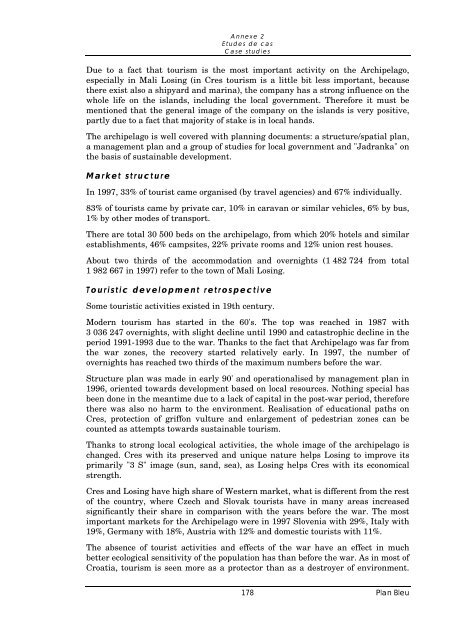MEDITERRANEAN ACTION PLAN
MEDITERRANEAN ACTION PLAN
MEDITERRANEAN ACTION PLAN
You also want an ePaper? Increase the reach of your titles
YUMPU automatically turns print PDFs into web optimized ePapers that Google loves.
Annexe 2<br />
Etudes de cas<br />
Case studies<br />
Due to a fact that tourism is the most important activity on the Archipelago,<br />
especially in Mali Losing (in Cres tourism is a little bit less important, because<br />
there exist also a shipyard and marina), the company has a strong influence on the<br />
whole life on the islands, including the local government. Therefore it must be<br />
mentioned that the general image of the company on the islands is very positive,<br />
partly due to a fact that majority of stake is in local hands.<br />
The archipelago is well covered with planning documents: a structure/spatial plan,<br />
a management plan and a group of studies for local government and "Jadranka" on<br />
the basis of sustainable development.<br />
Market structure<br />
In 1997, 33% of tourist came organised (by travel agencies) and 67% individually.<br />
83% of tourists came by private car, 10% in caravan or similar vehicles, 6% by bus,<br />
1% by other modes of transport.<br />
There are total 30 500 beds on the archipelago, from which 20% hotels and similar<br />
establishments, 46% campsites, 22% private rooms and 12% union rest houses.<br />
About two thirds of the accommodation and overnights (1 482 724 from total<br />
1 982 667 in 1997) refer to the town of Mali Losing.<br />
Touristic development retrospective<br />
Some touristic activities existed in 19th century.<br />
Modern tourism has started in the 60's. The top was reached in 1987 with<br />
3 036 247 overnights, with slight decline until 1990 and catastrophic decline in the<br />
period 1991-1993 due to the war. Thanks to the fact that Archipelago was far from<br />
the war zones, the recovery started relatively early. In 1997, the number of<br />
overnights has reached two thirds of the maximum numbers before the war.<br />
Structure plan was made in early 90' and operationalised by management plan in<br />
1996, oriented towards development based on local resources. Nothing special has<br />
been done in the meantime due to a lack of capital in the post-war period, therefore<br />
there was also no harm to the environment. Realisation of educational paths on<br />
Cres, protection of griffon vulture and enlargement of pedestrian zones can be<br />
counted as attempts towards sustainable tourism.<br />
Thanks to strong local ecological activities, the whole image of the archipelago is<br />
changed. Cres with its preserved and unique nature helps Losing to improve its<br />
primarily "3 S" image (sun, sand, sea), as Losing helps Cres with its economical<br />
strength.<br />
Cres and Losing have high share of Western market, what is different from the rest<br />
of the country, where Czech and Slovak tourists have in many areas increased<br />
significantly their share in comparison with the years before the war. The most<br />
important markets for the Archipelago were in 1997 Slovenia with 29%, Italy with<br />
19%, Germany with 18%, Austria with 12% and domestic tourists with 11%.<br />
The absence of tourist activities and effects of the war have an effect in much<br />
better ecological sensitivity of the population has than before the war. As in most of<br />
Croatia, tourism is seen more as a protector than as a destroyer of environment.<br />
178<br />
Plan Bleu
















